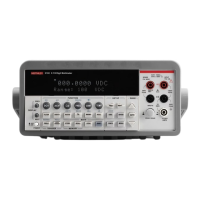Program messages
A program message is made up of one or more command words sent by the computer to the
instrument. Each common command is simply a three letter acronym preceded by an asterisk
(*). SCPI commands are categorized in the :STATus subsystem and are used to help explain how
command words are structured to formulate program messages.
:STATus Path (Root)
:OPERation Path
:ENABle <NRf> Command and parameter
:ENABle? Query command
:PRESet Command
Single command messages
The above command structure has three levels. The first level is made up of the root command
(:STATus) and serves as a path. The second level is made up of another path (:OPERation) and
a command (:PRESet). The third path is made up of one command for the :OPERation path. The
three commands in this structure can be executed by sending three separate program messages
as follows:
:stat:oper:enab <NRf>
:stat:oper:enab?
:stat:pres
In each of the above program messages, the path pointer starts at the root command (:stat)
and moves down the command levels until the command is executed.
Multiple command messages
You can send multiple command messages in the same program message as long as they are
separated by semicolons (;). Here is an example showing two commands in one program mes-
sage:
:stat:oper; :stat:oper:enab <NRf>
When the above is sent, the first command word is recognized as the root command (:stat).
When the next colon is detected, the path pointer moves down to the next command level and
executes the command. When the path pointer sees the colon after the semicolon (;), it resets
back to the root level and starts over.
Commands that are on the same command level can be executed without having to retype the
entire command path. Example:
:stat:oper:enab <NRf>; enab?
After the first command (:enab) is executed, the path pointer is at the third command level in
the structure. Since :enab? is also on the third level, it can be typed in without repeating the entire
path name. Notice that the leading colon for :enab? is not included in the program message. If a
colon were included, the path pointer would reset to the root level and expect a root command.
Since :enab? is not a root command, an error would occur.
4-36 Remote Operation

